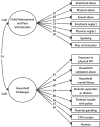Confirmatory factor analysis of adverse childhood experiences (ACEs) among a community-based sample of parents and adolescents
- PMID: 32316954
- PMCID: PMC7171813
- DOI: 10.1186/s12887-020-02063-3
Confirmatory factor analysis of adverse childhood experiences (ACEs) among a community-based sample of parents and adolescents
Abstract
Background: Despite increased understanding of Adverse Childhood Experiences (ACEs), very little advancement has been made in how ACEs are defined and conceptualized. The current objectives were to determine: 1) how well a theoretically-derived ACEs model fit the data, and 2) the association of all ACEs and the ACEs factors with poor self-rated mental and physical health.
Methods: Data were obtained from the Well-Being and Experiences Study, survey data of adolescents aged 14 to 17 years (n = 1002) and their parents (n = 1000) in Manitoba, Canada collected from 2017 to 2018. Statistical methods included confirmatory factor analysis (CFA) and logistic regression models.
Results: The study findings indicated a two-factor solution for both the adolescent and parent sample as follows: a) child maltreatment and peer victimization and b) household challenges factors, provided the best fit to the data. All original and expanded ACEs loaded on one of these two factors and all individual ACEs were associated with either poor self-rated mental health, physical health or both in unadjusted models and with the majority of findings remaining statistically significant in adjusted models (Adjusted Odds Ratios ranged from 1.16-3.25 among parents and 1.12-8.02 among adolescents). Additionally, both factors were associated with poor mental and physical health.
Conclusions: Findings confirm a two-factor structure (i.e., 1) child maltreatment and peer victimization and 2) household challenges) and indicate that the ACEs list should include original ACEs (i.e., physical abuse, sexual abuse, emotional abuse, emotional neglect, physical neglect, exposure to intimate partner violence (IPV), household substance use, household mental health problems, parental separation or divorce, parental problems with police) and expanded ACEs (i.e., spanking, peer victimization, household gambling problems, foster care placement or child protective organization (CPO) contact, poverty, and neighborhood safety).
Keywords: ACEs; Child maltreatment; Exposure to intimate partner violence; Household challenges; Neglect; Physical abuse; Sexual abuse; Spanking.
Conflict of interest statement
The authors declare that they have no competing interest.
Figures


References
-
- Felitti VJ, Anda RF. Nordenberg D, Williamson DF, Spitz a M, Edwards V, et al. relationship of childhood abuse and household dysfunction to many of the leading causes of death in adults. The adverse childhood experiences (ACE) study. Am J Prev Med. 1998;14:245–258. doi: 10.1016/S0749-3797(98)00017-8. - DOI - PubMed
Publication types
MeSH terms
Grants and funding
LinkOut - more resources
Full Text Sources
Medical

